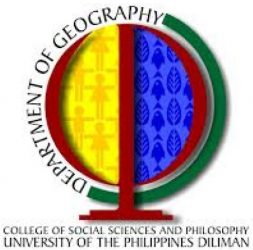Effective First Semester of Academic Year 2019-2020, BS Geography is a priority S&T program covered under the DOST-SEI Undergraduate Scholarships.
 Bachelor of Science, Major in Geography
Bachelor of Science, Major in Geography
The Bachelor of Science (Geography) Program engages students in diverse specializations within geography, such as environmental geography, media geography, spatial analysis and the applications of geographic information systems (GIS), climatology, cultural geography, transport and movement, land use, landform analysis, among other areas of the discipline. It lays the foundation for theories and methods in geography to equip students in applying geographic approaches to examine local and global experiences and issues as outcomes of complex physical and human processes. With a strong extension component that links academe with community, the program provides a rich learning experience that prepares students for careers in the academia, private sector, government agencies, non-government organizations, and other institutions.
Graduates of the program pursue professions or advanced degrees in resource management, urban planning, disaster risk reduction and management, geomatics, GIS, environmental science, education, among other fields of practice.
BS Geography Course Description
The undergraduate program consists of general education courses in the freshman and sophomore years including basic geography subjects. The junior and senior years are devoted to advanced and specialized training in the different sub-fields of Geography. A field geography course highlights the program by offering the students a venue for applying the theoretical foundations learned in the previous years.
The following are the courses under the BS Geography program:
GEOG 1. Places and Landscapes in a Changing World. An overview of the diversity of interconnections of people and places in a globalizing world as mediated by cultures, politics and historical development. 3 units
GEOG 31. Economic Geography of the Philippines. Distribution, variety and significance of natural resources and how the physical environment affects their use. 3 units
GEOG 100. Physical Geography. Systematic study of landforms, climate, natural vegetation and soils. 3 units
GEOG 101. Climatology. Climate elements, types and regions. 3 units
GEOG 103. World Regional Geography. World regions and their environmental systems, development processes, cultures and economies in the context of globalization. 3 units.
GEOG 104. Development of Geographic Thought. History and development of geography as a discipline and the evolution of the different schools of though and approaches. 3 units.
GEOG 105. Economic Geography. Geographic perspectives on economic patterns, processes and phenomena at various scales, including the location, distribution and spatial organization of economic activities across the world. 3 units
GEOG 109. Quantitative Methods in Geographic Analysis. Elements and applications of quantitative techniques in geography. 3 units
GEOG 111. Resource Management and Conservation. Concepts and approaches to the planning, management and conservation of natural resources. 3 units
GEOG 119. Geography of Movement. The study of movements of people, commodities, capital and information over a geographical space. 3 units
GEOG 121. Landform Analysis. Landform evaluation and analysis, map reading & photo interpretation, & applications of Geographic Information System (GIS) in terrain evaluation. Prereq: COI for non-majors. 4 units
GEOG 124. Geographic Information Systems for Human Geographic Research. Applications of Geographic Information Systems (GIS) in human geography.
GEOG 131. Geography of the Philippines. The role of human and natural resources in the economic growth and development of the Philippines. 3 units
GEOG 133. Geography of the Tropics. Physical environment and resource potential of the tropics. Problems of human use and occupance. 3 units
GEOG 135. Rural and Urban Geography. Concepts and approaches to understanding the relations between rural and urban spaces. 3 units
GEOG 143. Geography of Asia. The lands and peoples, climate, resources and economic activities of the countries of Southwest Asia; South Asia; Southeast Asia; East Asia; Central Asia; and Russian Siberia and Russian Far East, & their interrelations. 3 units
GEOG 145. Geography of the Pacific. The physical environment, natural and human resources, and economic development of Australia, New Zealand, New Guinea, Melanesia, Micronesia and Polynesia. 3 units
GEOG 151. Geography of Europe. Patterns of landforms, climate, resources and economic activities of the countries of Western Europe, Eastern Europe and Tanscaucasia, and their interrelations. 3 units
GEOG 155. Geography of North America. The physical environment, natural resources, and economic development of the countries of North America. 3 units
GEOG 157. Geography of South America. The physical environment, natural resources, and economic development of the countries of South America. 3 units
GEOG 159. Geography of Africa. The physical environment, natural resources, and economic development of the countries of Africa. 3 units
GEOG 161. Concepts and Principle of Land Use. Utilization and evaluation of land resources and land use allocation, development and causes of land misuse; land management and the application of Environmental Impact Assessment (EIA) principles to land use change. Prereq: COI for non-Geog majors. 3 units
GEOG 171. Political Geography. Investigation of political and territorial activities and structures at various geographical scales. 3 units
GEOG 173. Cultural Geography. A geographical investigation of the debates and discourses on cultural patterns and activities, distribution, movements, interactions, and landscapes of the world’s peoples. 3 units
GEOG 183. Transport Geography. Dynamics of transport systems and networks over geographical space. 3 units
GEOG 185. Medical Geography. Ecological spatial and social approaches in understanding the geographic aspects of health and health care systems. Prereq: COI for non-geog. 3 units
GEOG 190. Map & Air Photo interpretation. Elements, principles and techniques of map, aerial photo, and satellite image interpretation for spatial analysis and planning. Prereq: COI for non-geog. 3 units.
GEOG 192. Field Methods of Geography. Methods & techniques of observing geographic features, recording geographic data, & writing geographic reports. 6 wk. (field) 6 units
GEOG 197. Digital Cartography. Introduction to the concepts, principles, theories and applied components of Digital Cartography and Geographic Information Systems (GIS). 5 units
GEOG 198. Special Topics in Geography. 3 units
GEOG 199. Seminar. Methods, techniques, and problems of research. 3 units
GEOG 200. Thesis. Prereq: Senior Standing. 3 units
